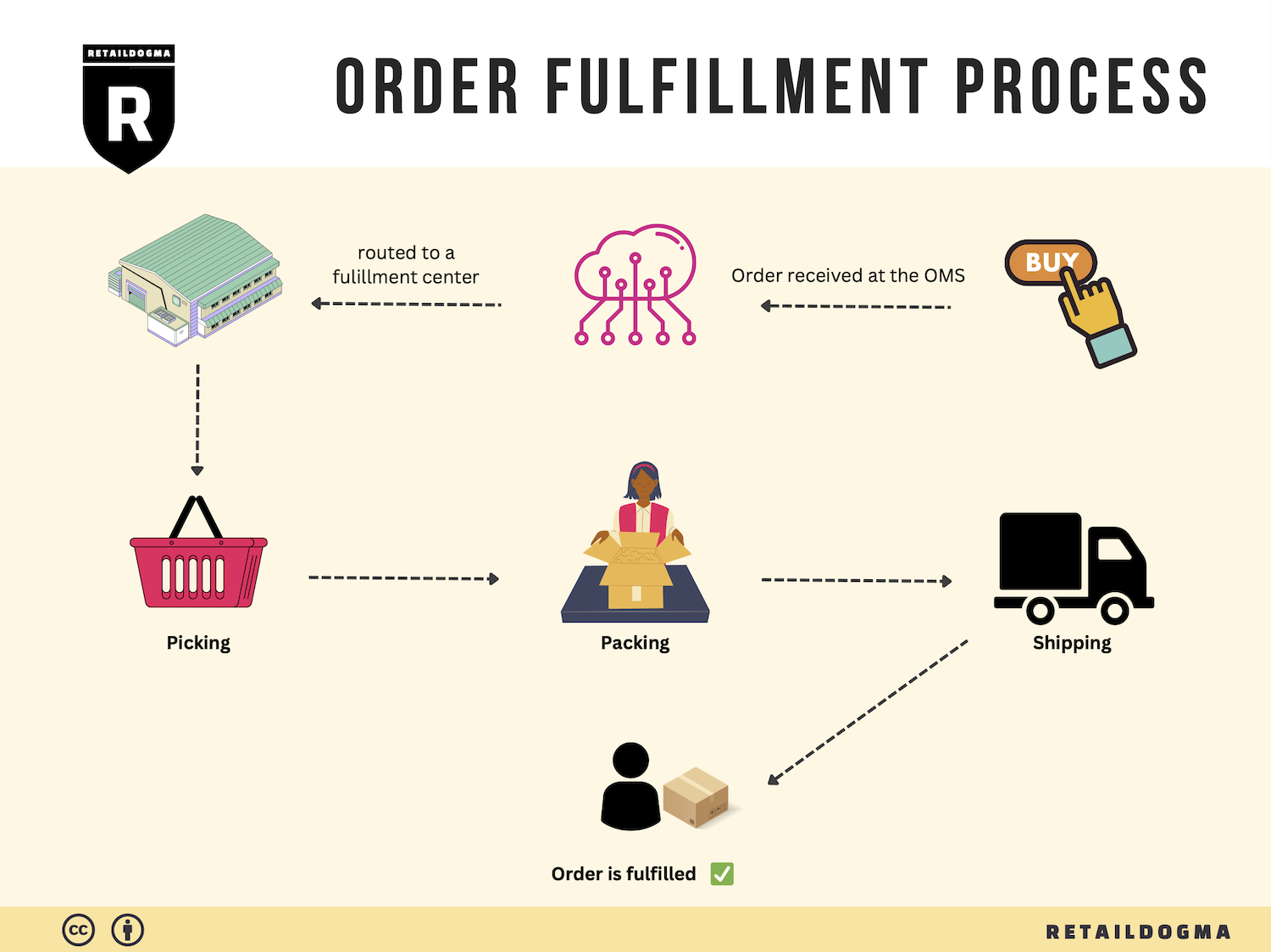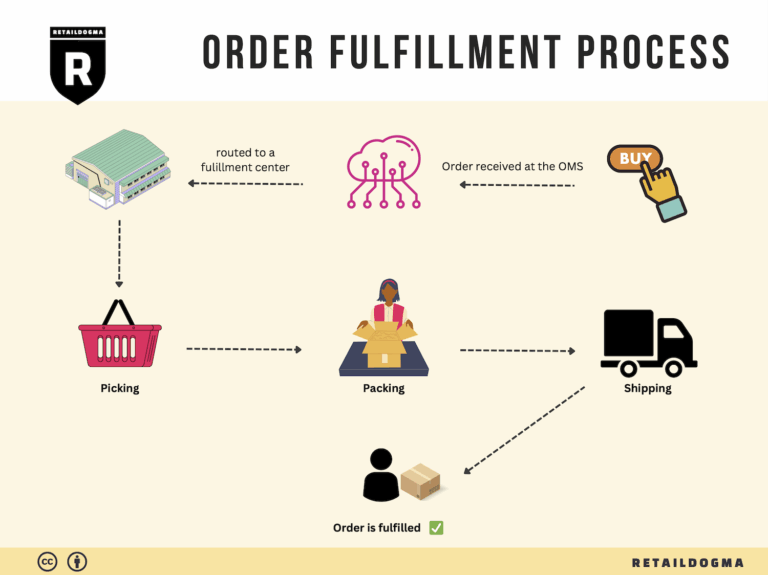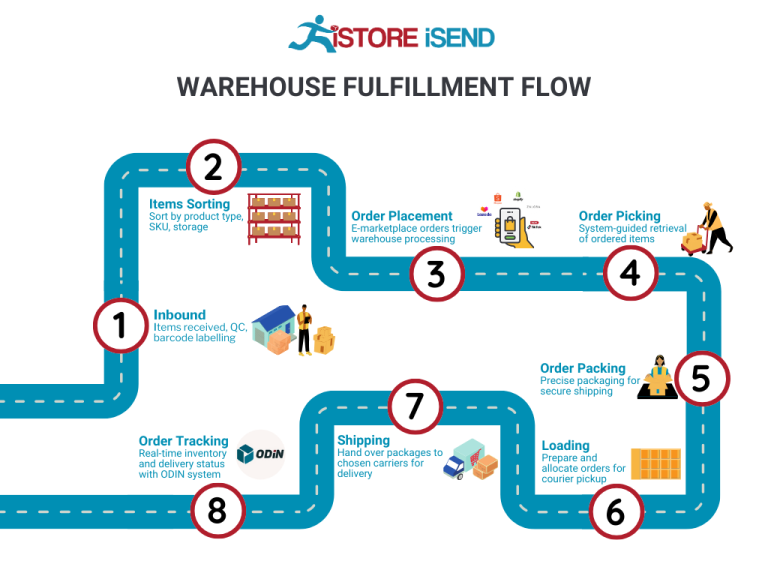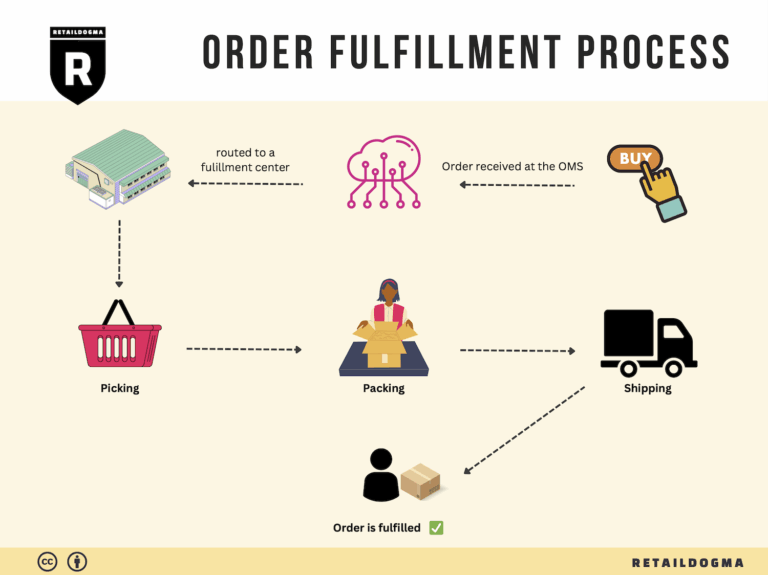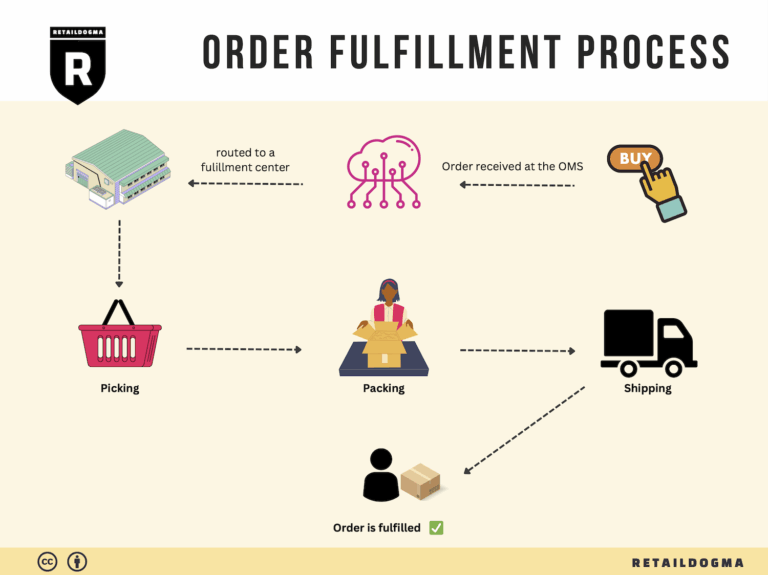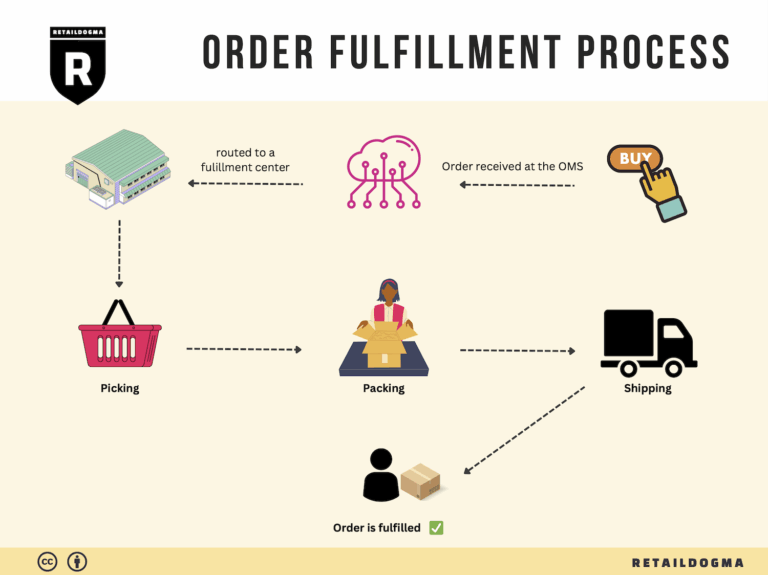Ecommerce Fulfillment Services: The Ultimate Guide (2025)
What is E-commerce Fulfillment? An Introduction for Growing Businesses
As your e-commerce business begins to grow, you might find yourself grappling with the complexities of packing and shipping orders. The excitement of increased sales can quickly turn into overwhelm as you face the logistical challenges of getting products to your customers efficiently and accurately. This is where understanding e-commerce fulfillment becomes crucial.
Fulfillment, in its simplest form, refers to the process of getting a product from your warehouse or fulfillment center to the customer’s doorstep. It encompasses everything from receiving inventory and processing orders to packaging and shipping items. As your business scales, streamlining this process is essential not only for maintaining customer satisfaction but also for optimizing your operational efficiency.
This guide will delve into several key aspects of e-commerce fulfillment to help you navigate these challenges. First, we will explore different fulfillment models, including Third-Party Logistics (3PL) and Fulfillment by Amazon (FBA). Each model has its own strengths and weaknesses, and understanding them will help you choose the best fit for your business needs.
Next, we will cover the core services typically offered by fulfillment centers. This includes inventory management, order processing, packaging, and shipping. By understanding these services, you can better assess potential partners and what they bring to the table.
Choosing the right fulfillment partner is a pivotal decision for any growing business. We will provide practical tips on how to evaluate potential partners based on criteria such as technology, scalability, customer service, and pricing.
Finally, we will discuss pricing structures for fulfillment services, helping you to understand the costs involved and how they can impact your overall profitability.
The ultimate goal of this guide is to empower you, as a business owner or operations manager, to make informed decisions regarding your logistics strategy. By optimizing your fulfillment processes, you can focus on what you do best—growing your business and delighting your customers. Let’s dive in and explore how effective e-commerce fulfillment can be a game-changer for your operations.
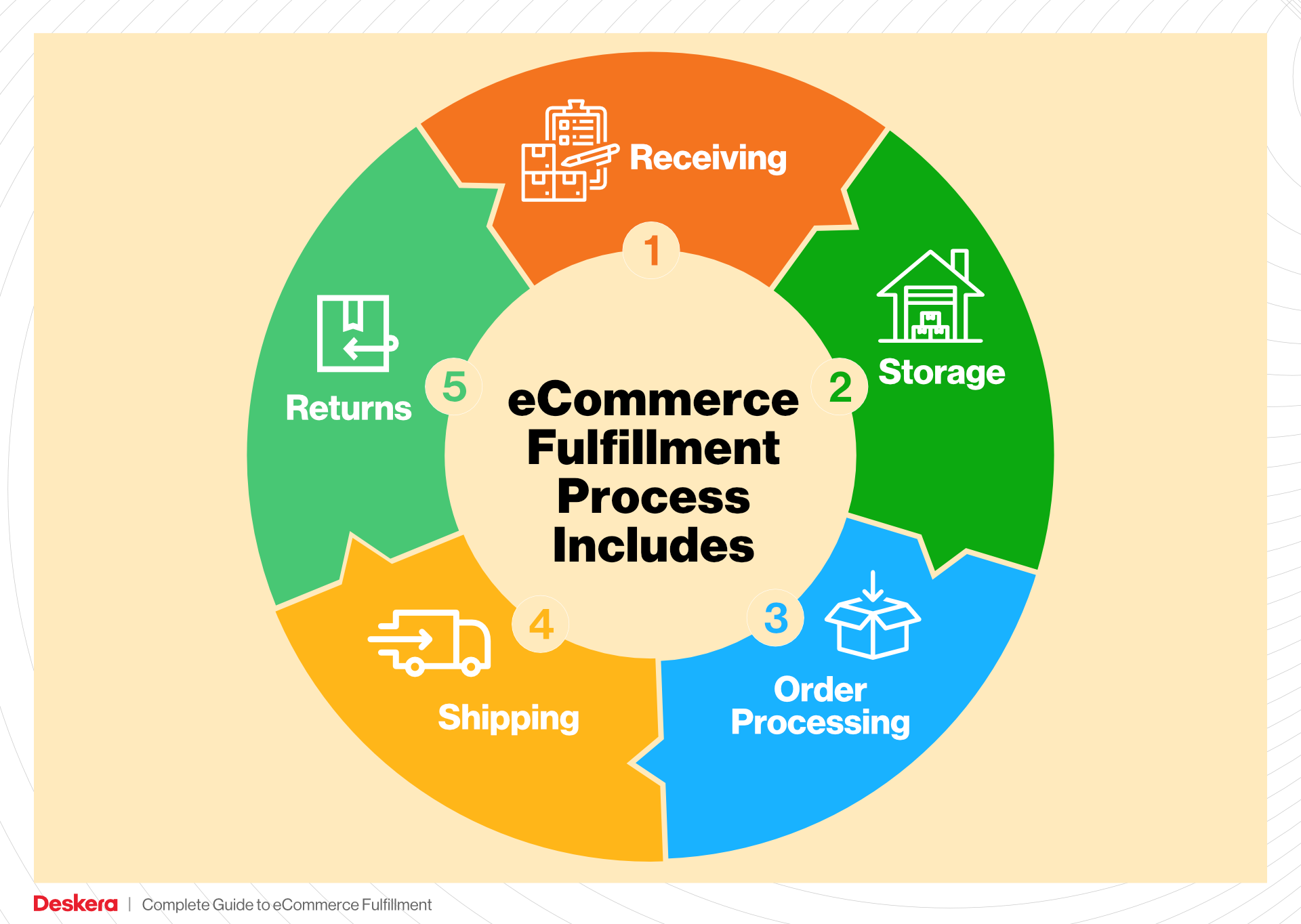
What You’ll Learn In This Guide
- What is E-commerce Fulfillment? An Introduction for Growing Businesses
- The Order Fulfillment Process: From ‘Buy’ Button to Customer’s Door
- Comparing Fulfillment Models: In-House vs. 3PL vs. Dropshipping
- A Deep Dive into Amazon FBA: Pros, Cons, and Who It’s For
- Core Services Offered by Fulfillment Centers
- How to Choose a Fulfillment Partner: A 6-Point Checklist
- Understanding Fulfillment Pricing: A Breakdown of Common Fees
- Frequently Asked Questions (FAQs) about Fulfillment
- Conclusion: Is Outsourcing Fulfillment the Right Move for Your Business?
- Important Disclaimer
The Order Fulfillment Process: From ‘Buy’ Button to Customer’s Door
1. Receiving Inventory
The order fulfillment process begins with receiving inventory, which is a crucial step for maintaining an efficient supply chain. When products arrive at your fulfillment center, they must be checked against purchase orders to ensure accuracy in quantity and condition. This step is vital for preventing stock discrepancies and ensuring that only quality products are stored and shipped to customers.
Key terms associated with this step include SKU (Stock Keeping Unit), which uniquely identifies each product. Properly managing SKUs helps streamline inventory tracking and facilitates quicker resolution of any discrepancies. Effective receiving processes involve not only checking the inventory but also entering the data into your inventory management system. This real-time data entry is essential for maintaining accurate stock levels and forecasting future inventory needs.
2. Warehouse Storage
Once the inventory has been received and verified, the next step is warehouse storage. This phase involves organizing products in a manner that maximizes space and accessibility. Effective storage strategies—like using a bin location system—help ensure that items can be easily located when orders come in.
The importance of this step cannot be overstated; a well-organized warehouse enhances operational efficiency and reduces the time spent searching for products. This is particularly critical in high-volume fulfillment centers where quick order turnaround is expected. Additionally, implementing a First-In-First-Out (FIFO) system ensures that older stock is shipped first, minimizing the risk of obsolescence or spoilage.
3. Order Picking
Order picking is the process of selecting items from the warehouse to fulfill customer orders. This step is crucial because it directly impacts customer satisfaction. A common method used in order picking is the pick list, which is generated from the orders received. This list details the items and quantities needed, guiding warehouse associates through the picking process.
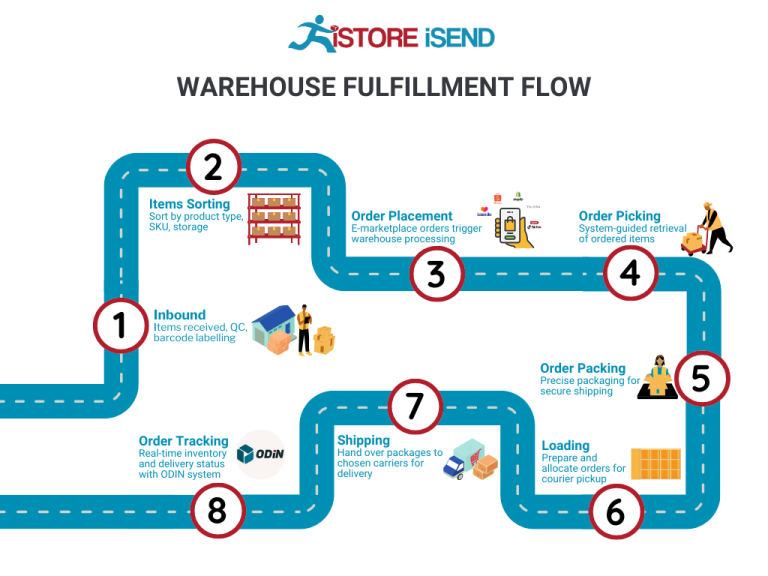
The efficiency of order picking can significantly affect overall fulfillment speed. Techniques such as batch picking (picking multiple orders at once) or zone picking (assigning associates to specific areas of the warehouse) can enhance productivity. Furthermore, investing in technology like barcode scanners or automated picking systems can streamline this process, reducing errors and improving accuracy.
4. Order Packing
After the items have been picked, they move to the packing stage. This step involves carefully packaging the products to ensure they arrive at the customer’s door in perfect condition. Proper packing is critical not only for product protection but also for optimizing shipping costs.
Key considerations during packing include using the right materials, such as void fill to prevent movement during transit, and ensuring that the packaging meets shipping carrier specifications. This is also the stage where shipping labels are generated, which include tracking information. Efficient packing processes can reduce shipping costs and enhance customer satisfaction, as well-packaged items are less likely to be damaged during transit.
5. Shipping & Delivery
The final step in the order fulfillment process is shipping and delivery. Once orders are packed, they are handed over to shipping carriers for delivery to customers. This phase is crucial as it represents the last touchpoint in the customer experience. Timely and accurate delivery is essential for maintaining customer satisfaction and loyalty.
Key terms associated with this step include last-mile delivery, which refers to the final leg of the shipping journey from the distribution center to the customer’s doorstep. Investing in logistics technology, such as route optimization software, can improve delivery efficiency and reduce costs. Moreover, providing customers with tracking information enhances transparency and allows them to anticipate their order’s arrival.

In conclusion, understanding and optimizing each step of the order fulfillment process is vital for e-commerce businesses looking to scale. By focusing on efficient receiving, storage, picking, packing, and shipping, businesses can enhance operational efficiency, reduce costs, and ultimately improve customer satisfaction.
Comparing Fulfillment Models: In-House vs. 3PL vs. Dropshipping
Fulfillment Models Comparison Table
| Model | Who Handles Inventory | Best For (Business Stage) | Key Advantage | Key Disadvantage |
|---|---|---|---|---|
| In-House Fulfillment | The Business | Startups to Established Firms | Greater control over inventory and processes | High overhead costs and resource demands |
| Third-Party Logistics (3PL) | 3PL Provider | Growing to Medium-Sized Firms | Scalability and flexibility in operations | Less control over inventory and processes |
| Dropshipping | Supplier or Manufacturer | Startups and New Entrepreneurs | Low startup costs and minimal risk | Lower profit margins and reliance on suppliers |
In-House Fulfillment
In-house fulfillment refers to when a business manages its own storage, inventory, packing, and shipping processes. This model is often favored by startups and established firms that require a higher level of control over their logistics operations. By handling fulfillment internally, businesses can maintain direct oversight of inventory management, quality control, and customer service. This can lead to improved brand loyalty and customer satisfaction, as companies can tailor their fulfillment practices to meet specific customer needs. However, the in-house model comes with significant overhead costs, including warehouse space, staffing, and equipment. Additionally, businesses may face challenges in scaling operations quickly in response to demand fluctuations, as in-house fulfillment often requires considerable investment in infrastructure.
Third-Party Logistics (3PL)
Third-party logistics providers offer businesses the opportunity to outsource their fulfillment operations. This model is particularly beneficial for growing to medium-sized firms that need to scale their logistics without the burden of investing in their own facilities. 3PLs handle everything from storage and inventory management to packing and shipping, allowing businesses to focus on core activities such as marketing and product development. The key advantage of using a 3PL is the flexibility it offers; businesses can easily adjust their logistics operations based on seasonal demand or market trends. However, this model can lead to a loss of control over inventory and fulfillment processes, which may impact customer experience. Additionally, businesses must carefully select a reliable 3PL partner to avoid potential issues with service quality and delivery times.
Dropshipping
Dropshipping is a fulfillment model where the retailer does not keep products in stock. Instead, when a customer places an order, the retailer purchases the item from a third-party supplier, who then ships it directly to the customer. This model is particularly attractive for startups and new entrepreneurs due to its low startup costs and minimal financial risk. Since there is no need for upfront inventory investment, businesses can offer a wide range of products without the associated storage costs. However, dropshipping comes with its own set of challenges. Profit margins tend to be lower compared to traditional retail models, as suppliers often take a significant cut of the sale price. Furthermore, retailers have little control over shipping times and product quality, which can lead to customer dissatisfaction if not managed properly. Building strong relationships with reliable suppliers is essential for success in this model.
Conclusion
Choosing the right fulfillment model is crucial for the success of an e-commerce business. Each model—whether in-house fulfillment, third-party logistics, or dropshipping—offers distinct advantages and disadvantages that must be weighed against the business’s specific needs and growth stage. By understanding the nuances of each model, e-commerce business owners can make informed decisions that align with their operational capabilities and customer expectations, ultimately driving growth and enhancing customer satisfaction.
A Deep Dive into Amazon FBA: Pros, Cons, and Who It’s For
What is Fulfillment by Amazon (FBA)?
Fulfillment by Amazon (FBA) is a service that allows e-commerce sellers to store their products in Amazon’s fulfillment centers. Amazon takes care of storage, packaging, and shipping directly to customers, providing a streamlined experience that can significantly reduce the operational burden on sellers. When a customer orders a product that is fulfilled by Amazon, the company manages the entire process, including customer service and returns. This service allows sellers to leverage Amazon’s vast logistics network, which is crucial for scaling their businesses.
How FBA Works
-
Setup: Sellers create an Amazon Seller Account and select the FBA option. They then list their products and prepare them for shipment to Amazon’s fulfillment centers.
-
Shipping to Amazon: Sellers pack their products according to Amazon’s guidelines and ship them to designated fulfillment centers. Amazon provides shipment plans to help sellers determine where to send their inventory.
-
Storage: Once the products arrive, they are stored in Amazon’s warehouses. Sellers can monitor their inventory levels through the Seller Central dashboard.
-
Order Fulfillment: When a customer places an order, Amazon takes care of picking, packing, and shipping the product. Orders are typically shipped via Amazon’s logistics network, which includes options for Prime shipping.
-
Customer Service: Amazon handles customer inquiries and returns for FBA products, ensuring a seamless experience for both sellers and buyers.
-
Payment: After a sale, sellers receive payment minus Amazon’s fees, which vary based on the product category and size.
Pros of FBA
-
Prime Eligibility: Products fulfilled through FBA are eligible for Amazon Prime, which can significantly boost sales. Prime members often prefer products with the Prime badge due to faster shipping options.
-
Customer Trust: By using FBA, sellers benefit from Amazon’s reputation for reliability and customer service. Customers are more likely to purchase products that are fulfilled by Amazon, knowing they can expect quality service.
-
Multi-Channel Fulfillment: FBA allows sellers to fulfill orders not only from Amazon but also from other sales channels, such as their own website or eBay. This flexibility is particularly advantageous for businesses looking to diversify their sales platforms.
-
Scalability: FBA helps sellers scale their operations without the need for significant investment in logistics and warehousing. As sales grow, Amazon’s infrastructure can support increased demand.
-
Inventory Management: With FBA, sellers can offload the complexities of inventory management to Amazon. This includes tracking stock levels and managing restocks, allowing sellers to focus on marketing and product development.
Cons of FBA
-
High Fees: FBA comes with various fees, including storage fees and fulfillment fees. These costs can add up, especially for sellers with low-margin products or those who keep inventory in Amazon’s warehouses for extended periods.
-
Strict Inventory Rules: Amazon has stringent guidelines regarding inventory management. Sellers must adhere to these rules to avoid penalties, which can be challenging for businesses that have fluctuating stock levels or seasonal products.
-
Commingling Risks: FBA operates on a commingling model, where inventory from multiple sellers can be stored together. This can lead to issues if a seller receives returns or damaged products that were originally sold by another seller, impacting their reputation and customer satisfaction.
-
Limited Control: By relying on Amazon for fulfillment, sellers lose some control over the customer experience. This includes aspects like packaging and shipping speed, which can vary based on Amazon’s operations.
-
Complex Return Processes: While Amazon handles returns, the process can be complicated for sellers. Returns may not always be tracked accurately, leading to potential losses if items are not returned in sellable condition.
Who is FBA Best For?
FBA is particularly beneficial for:
-
New Entrepreneurs: Those just starting out who want to leverage Amazon’s vast customer base without investing heavily in logistics.
-
Growing Brands: Established brands looking to scale quickly without the overhead of managing their own warehouses and fulfillment processes.
-
Sellers with Low-Margin Products: Businesses that sell products with low margins can benefit from the increased sales volume generated by Prime eligibility and customer trust.
-
Multi-Channel Sellers: Businesses that operate on various platforms and wish to simplify their logistics by using Amazon’s fulfillment services for multiple channels.
-
Seasonal Retailers: Sellers with seasonal products can use FBA to manage fluctuating inventory levels without committing to long-term warehousing solutions.
In conclusion, FBA offers a compelling solution for e-commerce sellers looking to streamline their operations and scale their businesses. However, it is crucial to weigh the pros and cons and consider individual business needs and goals before diving in.
Core Services Offered by Fulfillment Centers
Inventory Management & Warehousing
Effective inventory management and warehousing are foundational services offered by fulfillment centers, enabling e-commerce businesses to maintain optimal stock levels while minimizing overhead costs. Fulfillment centers utilize advanced inventory management systems that track stock levels in real-time, ensuring that businesses have access to accurate data regarding their inventory status.
Benefits:
- Reduced Overhead Costs: By outsourcing warehousing to a fulfillment center, businesses can save on the costs associated with maintaining their own warehouse space, such as rent, utilities, and staff.
- Scalability: Fulfillment centers allow businesses to easily scale their inventory according to demand fluctuations without the need for significant capital investment.
- Improved Accuracy: Automated inventory systems reduce the likelihood of human error, ensuring that businesses maintain accurate inventory records, which is crucial for fulfilling customer orders promptly.
- Space Optimization: Fulfillment centers are designed to maximize storage efficiency, enabling businesses to store more products in a smaller footprint.
In summary, robust inventory management and warehousing services equip e-commerce businesses with the agility needed to respond swiftly to market demands, enhancing customer satisfaction and operational efficiency.
Pick and Pack Services
Pick and pack services are at the heart of fulfillment operations. This process involves selecting items from the warehouse (picking) and preparing them for shipment (packing). Fulfillment centers employ efficient picking systems—often utilizing barcodes and RFID technology—to quickly and accurately gather the right products for each order.
Benefits:
- Speed and Efficiency: With trained staff and optimized processes, fulfillment centers can dramatically reduce the time it takes to pick and pack orders compared to in-house operations.
- Accuracy: Automated systems and trained personnel minimize the risk of errors, ensuring that customers receive the correct items in their orders, which is essential for maintaining customer trust.
- Customization: Many fulfillment centers offer customization options for packaging, which can enhance the customer experience and strengthen brand identity.
- Scalability: As e-commerce businesses grow, fulfillment centers can easily scale their pick and pack operations to accommodate increased order volumes without the need for significant operational changes.
By leveraging efficient pick and pack services, e-commerce businesses can enhance their order fulfillment speed and accuracy, leading to higher customer satisfaction and repeat business.
Kitting and Assembly
Kitting and assembly services involve grouping together multiple products into a single package or assembling components to create a finished product. This service is particularly beneficial for businesses that sell bundled products or require assembly before shipping.
Benefits:
- Enhanced Product Offering: Kitting allows businesses to create unique product bundles that can attract more customers and increase average order values.
- Time Savings: By outsourcing kitting and assembly to a fulfillment center, businesses can save time and focus on their core competencies, such as product development and marketing.
- Quality Control: Fulfillment centers often have quality control processes in place to ensure that assembled products meet specific standards, reducing the risk of returns and customer dissatisfaction.
- Inventory Management: Kitting can help streamline inventory management by consolidating several items into one SKU, simplifying tracking and reducing storage costs.
Kitting and assembly services enable e-commerce businesses to offer more diverse products, enhance customer experience, and optimize their logistics operations.
Returns Management (Reverse Logistics)
Returns management, also known as reverse logistics, is a critical service that fulfillment centers provide to handle the complexities of product returns. This process involves receiving returned items, inspecting them, restocking them if they are in sellable condition, or managing repairs and disposals if they are not.
Benefits:
- Customer Satisfaction: Efficient returns management systems enhance customer satisfaction by making the returns process straightforward and hassle-free, which is vital for maintaining customer loyalty.
- Cost Reduction: Fulfillment centers can streamline the returns process, reducing the costs associated with handling returns in-house, including labor and shipping expenses.
- Data Insights: Analyzing return data can provide valuable insights into customer behavior and product performance, enabling businesses to make informed decisions about inventory and product offerings.
- Sustainability: Many fulfillment centers are increasingly focusing on sustainable practices in reverse logistics, such as recycling or refurbishing returned products, which can enhance a brand’s reputation.
By effectively managing returns, e-commerce businesses can turn potential challenges into opportunities for improvement, ensuring a positive experience for customers and optimizing operational efficiency.
In conclusion, the core services offered by fulfillment centers—inventory management and warehousing, pick and pack services, kitting and assembly, and returns management—are essential for e-commerce businesses looking to scale their operations. By leveraging these services, businesses can enhance efficiency, reduce costs, and improve customer satisfaction, ultimately driving growth in a competitive marketplace.
How to Choose a Fulfillment Partner: A 6-Point Checklist
Location & Warehouse Network
The geographical location of your fulfillment partner’s warehouses is critical for ensuring timely and cost-effective delivery. A strategically placed fulfillment center can significantly reduce shipping times and costs, which is essential for maintaining customer satisfaction in today’s fast-paced e-commerce environment.
Questions to Ask:
– Where are your warehouses located, and how does that align with my target customer base?
– What is the average shipping time from your warehouses to key regions?
– Do you have a network of warehouses that can facilitate multi-channel distribution (e.g., retail, e-commerce)?
Technology & Integrations
In the digital age, technology plays a vital role in streamlining fulfillment processes. A good fulfillment partner should have a robust technology stack that integrates seamlessly with your e-commerce platform. This will help automate order processing, inventory management, and tracking, thus reducing human error and improving efficiency.
Questions to Ask:
– What warehouse management system (WMS) do you use, and how does it integrate with my existing systems?
– Do you provide real-time inventory tracking and reporting?
– Can you support various shipping carriers and methods?
Specializations (e.g., Cold Storage, Oversized Items)
Not all fulfillment centers are equipped to handle specialized products. If you sell items that require specific storage conditions (like food or pharmaceuticals) or oversized products (like furniture), it’s essential to partner with a fulfillment center that has the necessary capabilities.
Questions to Ask:
– Do you have the capacity and expertise to handle my specific product types?
– What measures do you have in place for temperature control or special handling?
– Can you accommodate varying sizes and weights of products without compromising on service quality?
Scalability & Capacity
As your business grows, your fulfillment needs will change. It’s crucial to partner with a fulfillment provider that can scale operations to match your growth trajectory. Whether you’re experiencing seasonal spikes in demand or planning for long-term growth, your fulfillment partner should be able to adapt.
Questions to Ask:
– How do you manage capacity during peak seasons?
– Can you provide examples of how you’ve supported clients during rapid growth?
– What is your process for onboarding new products or increasing order volume?
Pricing and Contracts
Understanding the cost structure of your fulfillment partner is vital for maintaining profitability. Be wary of hidden fees and unclear pricing models. A transparent pricing structure will help you forecast costs and avoid unexpected expenses.
Questions to Ask:
– What is included in your pricing model? Are there any additional fees (e.g., storage, picking, packing)?
– How do you handle pricing adjustments during peak seasons?
– Can you provide a sample contract that outlines terms, conditions, and cancellation policies?
Customer Support & Reviews
Reliable customer support is essential for resolving issues quickly and maintaining operational efficiency. Additionally, reviewing feedback from other businesses that have worked with a potential partner can provide insights into their service quality and reliability.
Questions to Ask:
– What level of support do you offer (e.g., dedicated account manager, 24/7 support)?
– How do you handle customer service inquiries or operational issues?
– Can you provide references or case studies from businesses similar to mine?
Conclusion
Choosing the right fulfillment partner can make or break your e-commerce operations. By following this checklist and asking the right questions, you can ensure that your chosen partner aligns with your business goals and can support your growth. Remember, a successful partnership is built on transparency, trust, and mutual benefit. Take the time to evaluate potential partners thoroughly to set your business up for success in the competitive e-commerce landscape.
Understanding Fulfillment Pricing: A Breakdown of Common Fees
Initial Setup Fees
Initial setup fees are typically charged when you first engage a fulfillment center. This fee covers the administrative costs of onboarding your business, including account creation, system integration, and any necessary training. The fee can vary widely depending on the fulfillment center’s policies and the complexity of your operations.
In many cases, these fees may be a flat rate, ranging from $100 to $500, but can also be calculated based on the specific services required. For instance, if you need custom software integration or specialized packaging solutions, expect to pay more. Always inquire about what exactly is included in the setup fee to avoid surprises.
Receiving Fees
Receiving fees are charged when the fulfillment center receives your inventory. This fee compensates the center for inspecting, sorting, and storing your products. Typically calculated per pallet or per hour spent receiving goods, these fees can range from $20 to $50 per pallet, depending on the complexity of the items being received and the efficiency of the facility.
To calculate receiving fees, fulfillment centers may consider factors such as the number of items in a shipment, the time taken for unloading, and any special handling required (e.g., fragile items or hazardous materials). Businesses should ensure that they provide accurate inventory counts and descriptions to avoid additional charges stemming from discrepancies.
Storage Fees (per pallet/bin)
Storage fees are incurred for the space your products occupy in the fulfillment center. These fees are usually calculated on a per-pallet or per-bin basis, typically charged monthly. Storage fees can range from $15 to $40 per pallet per month, depending on the facility’s location, demand, and the nature of your inventory.
It’s essential to understand how storage fees are calculated, especially if you have seasonal products or a fluctuating inventory. Some fulfillment centers may also offer tiered pricing for long-term storage, which can help mitigate costs for products that do not move quickly. Businesses should regularly assess their inventory turnover to optimize storage costs.
Pick & Pack Fees (per item/order)
Pick and pack fees are charged for the labor involved in selecting items from the warehouse and packing them for shipment. These fees can be structured in various ways: per item, per order, or a combination of both. Typically, businesses can expect to pay between $1 and $5 per item, depending on the complexity of the order and the specific handling requirements.
When calculating pick and pack fees, fulfillment centers often consider factors such as the number of items in an order, the packing materials used, and any special instructions provided by the seller (e.g., gift wrapping). To manage costs effectively, e-commerce businesses should streamline their product offerings and consider bulk orders when possible.
Shipping Fees
Shipping fees are a crucial component of fulfillment pricing, as they cover the cost of transporting your products to customers. These fees vary based on several factors, including package weight, dimensions, shipping speed, and destination. Fulfillment centers typically have partnerships with major carriers, which can influence the rates they offer.
Shipping fees can be calculated in various ways: flat rate, zone-based pricing, or dimensional weight pricing. Businesses should understand the shipping strategy employed by their fulfillment center to anticipate costs accurately. Additionally, consider leveraging discounted shipping rates available through fulfillment centers or negotiating better terms based on your shipping volume.
Tips for Getting an Accurate Quote
-
Understand Your Needs: Before reaching out for a quote, clearly define your business requirements, including inventory volume, order frequency, and specific handling needs.
-
Request Detailed Quotes: Ask for a breakdown of all potential fees, including setup, receiving, storage, pick and pack, and shipping fees. This transparency will help you understand the total cost of fulfillment.
-
Compare Multiple Providers: Don’t settle for the first quote you receive. Comparing several fulfillment centers can provide insights into industry standards and help identify the best fit for your business.
-
Negotiate Terms: If you anticipate high volumes, don’t hesitate to negotiate terms. Many fulfillment centers are willing to offer discounts for long-term contracts or larger order volumes.
-
Review Contracts Carefully: Ensure you understand all terms and conditions outlined in the contract, including any potential hidden fees or penalties for low inventory turnover.
By understanding these common fulfillment pricing models and following the tips provided, e-commerce businesses can make informed decisions that align with their operational needs and financial goals.
Frequently Asked Questions (FAQs) about Fulfillment
1. What is a fulfillment center warehouse associate?
A fulfillment center warehouse associate is a key player in the logistics and supply chain operations of e-commerce businesses. These associates are responsible for a variety of tasks, including picking, packing, and shipping customer orders, as well as managing inventory and maintaining the organization of the warehouse. Their role ensures that products are delivered to customers accurately and on time, which is crucial for customer satisfaction and retention.
2. What are the typical responsibilities of a fulfillment center warehouse associate?
Fulfillment center warehouse associates typically handle tasks such as:
– Picking items from shelves based on customer orders.
– Packing products securely to prevent damage during shipping.
– Labeling packages for delivery.
– Assisting with inventory management and stock replenishment.
– Maintaining cleanliness and organization within the warehouse.
– Operating machinery or equipment as needed, such as forklifts or conveyor belts.
3. How does a fulfillment center differ from a traditional warehouse?
A fulfillment center is specifically designed for the rapid processing and shipping of online orders, whereas a traditional warehouse may focus more on long-term storage of goods. Fulfillment centers often employ advanced technology and automated systems to streamline order processing, while traditional warehouses might not prioritize speed and efficiency to the same extent.
4. What is a Third-Party Logistics Provider (3PL)?
A Third-Party Logistics Provider (3PL) is a company that offers outsourced logistics services, which can include warehousing, fulfillment, transportation, and distribution. Businesses often partner with 3PLs to scale their operations without the need for significant investment in their own logistics infrastructure. This allows companies to focus on core competencies such as marketing and product development while relying on 3PLs for efficient order fulfillment.
5. How much do fulfillment services typically cost?
The cost of fulfillment services can vary widely depending on several factors, including the volume of orders, the size and weight of products, and specific services required (e.g., packaging, storage, and shipping). On average, businesses might expect to pay a combination of a per-order fee, storage fees for inventory held at the fulfillment center, and shipping fees based on the destination and carrier used. It’s essential to compare multiple providers to find the best fit for your budget and service needs.
6. What skills are essential for a fulfillment center warehouse associate?
Key skills for fulfillment center warehouse associates include:
– Attention to detail to ensure accurate order fulfillment.
– Strong organizational skills to manage inventory effectively.
– Physical stamina to handle lifting and moving products.
– Basic computer skills for inventory management systems.
– Teamwork and communication skills to work effectively with colleagues and supervisors.
7. What technology is commonly used in fulfillment centers?
Fulfillment centers leverage various technologies to enhance efficiency, including:
– Warehouse Management Systems (WMS) for tracking inventory and orders.
– Barcode scanning systems for accurate picking and packing.
– Automated sorting systems to expedite order processing.
– Robotics and AI for tasks like picking and packing, which improve speed and accuracy.
8. How do fulfillment centers handle returns?
Fulfillment centers typically have a streamlined process for handling returns, which may involve:
– Inspecting returned items to assess their condition.
– Restocking items that are in sellable condition.
– Processing refunds or exchanges for customers.
– Updating inventory levels in the warehouse management system to reflect the return.
9. What are the benefits of using a fulfillment center for my e-commerce business?
Utilizing a fulfillment center offers several benefits, including:
– Increased efficiency in order processing and shipping.
– Scalability to manage fluctuating order volumes without significant overhead costs.
– Access to advanced logistics technology and expertise.
– Improved customer satisfaction through faster shipping and accurate order fulfillment.
10. How can I choose the right fulfillment center for my business?
To select the right fulfillment center, consider the following factors:
– Location: Proximity to your customer base can reduce shipping times and costs.
– Services offered: Ensure the center can handle your specific needs, such as special packaging or handling requirements.
– Technology: Look for centers that utilize advanced technology for inventory management and order processing.
– Pricing: Compare costs across different providers to find a balance between service quality and affordability.
– Reviews and reputation: Research customer feedback and case studies to gauge the reliability and performance of potential partners.
Conclusion: Is Outsourcing Fulfillment the Right Move for Your Business?
Evaluating the Benefits of Outsourcing Fulfillment
Outsourcing fulfillment can be a transformative move for e-commerce businesses looking to scale efficiently. One of the primary advantages is the significant time savings it offers. By delegating order processing, inventory management, and shipping logistics to a dedicated fulfillment center, business owners can focus on core activities such as marketing, product development, and customer engagement. This shift not only enhances operational efficiency but also allows for a more strategic allocation of resources.
Scalability is another compelling reason to consider a fulfillment partner. As your business grows, so do your logistics needs. A fulfillment service can easily adjust to fluctuating order volumes without the need for substantial investments in infrastructure or personnel. This flexibility ensures that you can respond quickly to market demands, whether it’s during peak seasons or unexpected surges in sales.
Moreover, partnering with a fulfillment center brings a wealth of expertise and technology that might be challenging to replicate in-house. These centers are often equipped with advanced inventory management systems, state-of-the-art warehousing solutions, and logistics networks that can optimize delivery times and costs. Their operational know-how can significantly enhance your customer satisfaction and retention rates.
However, the success of outsourcing fulfillment largely depends on choosing the right partner. It’s crucial to evaluate potential fulfillment services based on their reliability, technology capabilities, and alignment with your business goals.
Next Steps
To determine if outsourcing fulfillment is the right step for your business, consider conducting a thorough audit of your current shipping and logistics processes. Identify bottlenecks, inefficiencies, and growth potential. This analysis will provide valuable insights that can guide your decision-making and help you select a fulfillment partner that aligns with your growth trajectory. Take action today to streamline your operations and position your business for future success.
Important Disclaimer
⚠️ Important Disclaimer
The information in this guide is for educational purposes. Fulfillment services, pricing, and platform features change frequently. Always conduct your own due diligence and consult with providers directly before making business decisions.
